Rank Math’s SEO score and Content AI score might look similar in the first instance, but they are fundamentally different in what they convey.
The SEO score is a measure of how well your content is optimized for basic SEO practices. To calculate the SEO score, Rank Math performs basic SEO tests on your content to see if it uses focus keyword(s), links to external resources, etc.
On the other hand, our Content AI analyzes your focus keyword with the data from existing search results to give you intelligent suggestions on how many words, headings, links, media to be used, what keywords can be used, and what links can be added. Then our AI measures how well your content is optimized for the provided suggestions to rate them with the Content AI score.
To keep it simple,
- SEO score is for how well your content is optimized for the overall SEO such as SEO meta tags, readability, links, etc.
- Content AI score is for how well the content is written around the target keyword.
Note: Using the Content AI makes the SEO Score more “intelligent”. Some of the tests in SEO Score that are based on generic industry standards will be utilizing the data available in the Content AI instead. For example, the content length test starts giving you points when you reach half the content length recommended by Content AI – instead of the generic 600 words recommendation. So, Content AI is very important for a smarter SEO Score.
While this is the basic difference between SEO score and Content AI score, we’ll discuss them more in detail in this knowledgebase article. And if you want to quickly jump into the tests for Rank Math SEO score and Content AI score, simply click through the link in the following table.
Table of Contents
1 What is Rank Math’s SEO Score?
Rank Math performs 21 real-time tests to see if your content is optimized for search engines and follows the best SEO practices.
To help you get an overall idea of how well your content fared/optimized, Rank Math gives an overall SEO score on a scale of 100. The SEO score and the results of the tests can be found right inside your familiar Rank Math Metabox, as shown below.
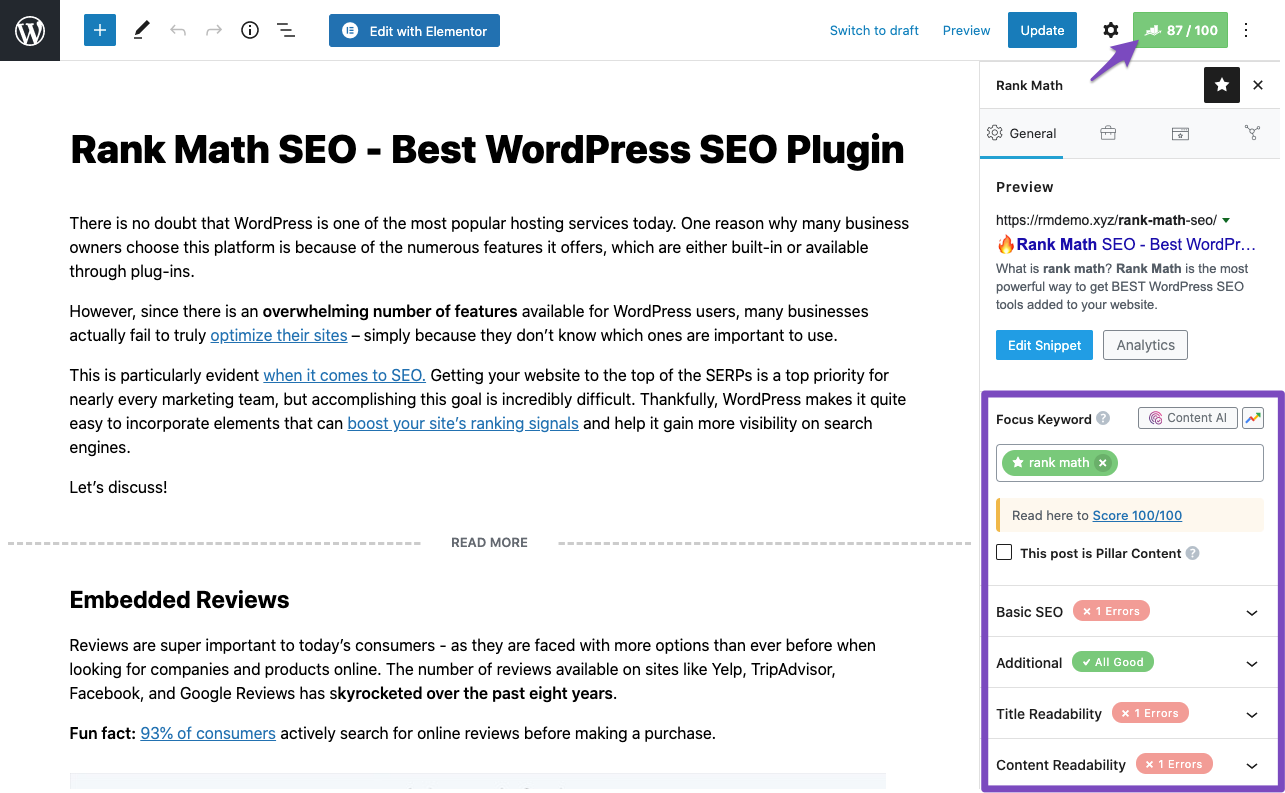
As you might have noticed, our score is color-coded and based on your content score, they would appear as Red, Yellow, or Green. So let’s understand what these color codes/scores mean:
Green [81+ Score]
Rank Math SEO score appears as green when the overall score is greater than 80. This indicates that your post is ready to be published.
However, if you’re just above 80, we would still recommend optimizing your article further to reach a score closer to 100. We have a dedicated knowledgebase article to help you with it.
Yellow [51-80 Score]
If your overall SEO score is somewhere in the range of 51-80, it would appear yellow. This means that your post is not fully optimized and has plenty of room for improvement.
In this case, we would recommend optimizing the post further to reach the overall SEO score green, which includes the higher probability of ranking in search results.
Red [Below 50 Score]
Your Rank Math SEO score appears as red if your overall score is below 50. This simply indicates that your post is not optimized for the focus keyword, and the chances of ranking higher in search results are really low.
We would recommend you start working on the optimizations that Rank Math offers to achieve an overall SEO score of Yellow/Green.
1.1 How Content Analysis Tests Are Color-Coded?
As we mentioned, the overall SEO score is calculated based on whether you pass/fail the individual tests. Similar to the overall SEO score, the individual tests are also color-coded to give you a quick understanding of the test results.
For the tests we’d be discussing below, Rank Math color codes them as:
Green Tick: A Green tick in front of a test means you’ve passed with flying colors.
Yellow: If you see the color Yellow on a test, that means your post isn’t optimized for the test, and you should spend some time fixing it.
Red Cross: If you see a Red Cross icon, then that means your post has performed poorly on this test. We recommend that you optimize the content before you publish it to maximize the chances of rankings and traffic.

Now that we’ve understood how to infer the color codes let’s dive into the content analysis tests that Rank Math would evaluate your content with.
1.2 Basic SEO Tests
As it goes by the name, Rank Math checks for the basic SEO with these tests, mainly focused on checking if the focus keyword(s) are used:
Focus Keyword in the SEO Title: For this test, Rank Math would check if your primary focus keyword is present in the SEO title. This test would not consider secondary focus keywords, as it’s not practical to have all your focus keywords in the title.
Focus Keyword in the Meta Description: For this test, Rank Math would look for the presence of the primary focus keyword in the meta description. If you have entered a custom SEO description, Rank Math will look for the focus keyword here. If a custom SEO description is not set, Rank Math will automatically create a description and then test it to see if the focus keyword is included.
Focus Keyword in the URL: For this test, Rank Math will look for the presence of the primary focus keyword in the URL, as it is not practical to add all the focus keywords in your URL without making a mess.
Focus Keyword at the beginning of the content: Rank Math will check your content to see if the primary focus keyword is present in the first 10% of your post, and if it finds, you’ll pass this test.
Focus Keyword in the Content: Rank Math checks if your focus keywords (primary and secondary focus keywords) are present in the content. With that said, if your content includes too many focus keywords, it would look unnatural for your readers. If your post includes excessive use of keywords, it is recommended to reduce your keyword usage and make it sound natural.
Overall Content Length: In this test, Rank Math scores your content based on its length. Here is a simple reference guide to remember.
- More than 2500 words: 100% score
- 2000-2500 words: 70% score
- 1500-2000 words: 60% score
- 1000-1500 words: 40% score
- 600-1000 words: 20% score
- Below 600 words: 0% score
Note: Content-Length test is synced with Content AI’s word count recommendations. When you use Content AI for your content optimization, the above percentage score is not relevant to it, and you’ll have appropriate word count suggestions for that exact focus keyword based on research.
If you pass all the basic SEO tests, then Rank Math will score All Good, as shown below. In case if you fail any test, you can follow our recommendations to pass the test.
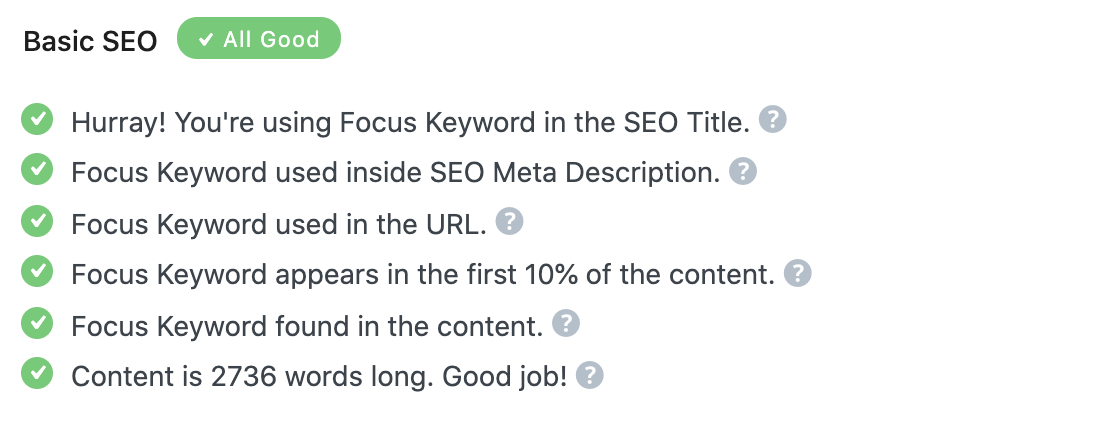
1.3 Additional SEO Tests
The Additional SEO tests look for more SEO optimizations, and here are the additional SEO tests that Rank Math performs on your content:
Focus Keyword in Subheading: In this test, Rank Math will look for the presence of your focus keyword in the H2, H3, and other tags. This test is applicable for primary as well as secondary focus keywords. Using keywords in headings not only improves the article’s relevancy but also helps achieve site links in search results.
Focus Keyword in Image ALT Attributes: Rank Math will look for your primary focus keyword in your images’ ALT text. Both the singular and the plural version of the keyword are considered when performing this test, and you’ll pass the test if Rank Math finds any one of the variations in the ALT text.
Keyword Density: While keyword density is becoming less important, optimizing your posts with a good keyword density will give you an edge in search results. Rank Math looks for the presence of primary and secondary focus keywords and calculates the keyword density. Although there is no perfect keyword density, it should never be overdone, and a keyword density of 1-1.5% is sufficient in most cases.
Note: When you use Content AI, the keyword density test will be synced with the first keyword suggested by Content AI to use in your content.
URL Length: Shorter URLs are known for having a higher chance in SERPs. In this test, Rank Math checks the length of your URL and lets you know if it is too long. So, if your URL length is equal to or less than 75 characters, then you will pass the test.
Linking to External Sources: Rank Math will check if you’re linking out to a few external resources in this test. If you’re not, then you’ll fail this test, and you will need to add a few relevant links to external websites to pass this test.
Note: Linking to external sources test will be synced to Content AI’s external link count suggestions. If Content AI suggests not to add external links, this test would be hidden.
Linking to External Content with a Followed Link: For this test, Rank Math will look for the presence of a dofollow external link. This test is dependent on the previous test to link out external sources. After all, how will you make a link dofollow if you don’t add one?
Note: Rank Math leaves this test hidden when Content AI suggests not to link the external content with a followed link.
Linking to Internal Resources: While the previous two tests were for external links, this test is for internal links. Rank Math checks your post in real-time and notifies you if your post does not have any internal links. To pass this test, include relevant internal links from this post to other posts on your site. The following types of links qualify for this test:
- Links to other posts on your website
- Links to other subdomains on your main domain
- Links to the main domain from a subdomain
Note: Like the external links, this test is synced with internal link count suggestions. When you use Content AI, and it recommends not to add internal links to your content, then the linking to the internal resources test would be hidden.
Focus Keyword Uniqueness: In this test, Rank Math will check if you’ve already used this focus keyword on any other post on your website, as creating multiple posts for the same focus keyword leads to the possibility of duplicate content. Rank Math considers only the primary focus keyword for this test.
Content AI Test: Here, Rank Math will check whether you’ve used Content AI to optimize your post for the focus keyword. As you know, Content AI provides additional recommendations for optimal word count, media count, heading count, and link count to use in your content. Besides Content AI also provides you keywords to use, Questions to answer, and external credible sources you can link to.
When you pass all these additional SEO tests, you’ll notice Rank Math scoring All Good like this:
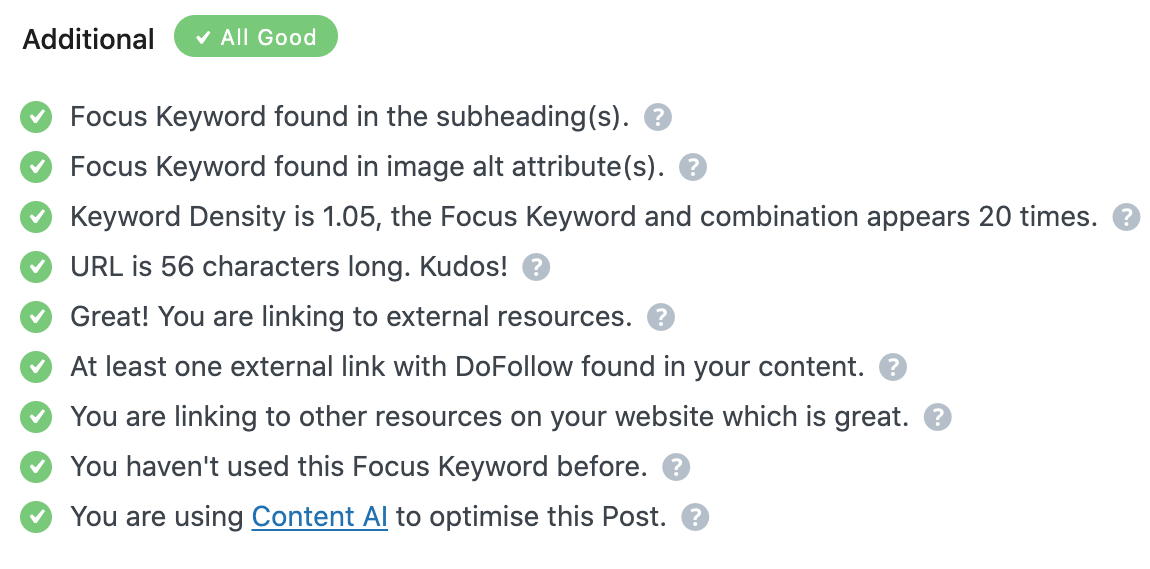
1.4 Title Readability Tests
The next set of tests is intended to see if your title is readable. Let’s look at each test and how you can pass the test.
Focus Keyword at the beginning of the SEO Title: Rank Math will check if you’ve placed your primary focus keyword in the first 50% of the title, and if you have, you’ll pass the test. Rank Math checks the focus keyword in the first 50% of the title and not at the beginning of the title, as sometimes, it is not practical to place your focus keywords at the beginning of your post without it making it look unnatural. Similarly, having all your focus keywords in the title is not practical, so the test is only for the primary focus keyword.
Sentiment in a Title: A proven way to get more people to click on your website in the SERPs is to have a title that evokes strong emotions. To pass this test, make sure that your title evokes a strong emotion from the user. Sometimes, it is easier said than done, but many times, just replacing a few words from your title should do the trick.
Use of Power Word in Title: Power words, when used in titles, compel users to click-through. In this test, Rank Math will check if you’re using a power word in the title. The test is performed using an internal list of power words, which is regularly updated. If a power word is found, you’ll pass the test; else, you’ll fail the test. To learn more about power words, you can refer to our dedicated guide about power words.
Number in Title: A proven way to get more clicks from the SERPs is to use numbers in the title. So in this test, Rank Math will check if you’re using numbers in your title. If not, Rank Math will warn you that you should. So, to pass this test, all you have to do is include a number in the post’s title.
If you pass all these title readability tests, then Rank Math will score it All Good, just as shown below. If you fail any test, you can follow Rank Math’s recommendations to pass the test.

1.5 Content Readability Tests
The last set of tests check the readability of your content, and let’s look at what they are:
Use a Table of Contents: Including a table of contents makes the navigation easier for longer posts. So in this test, Rank Math will look for the presence of a table of contents. Since there is no direct way to detect a TOC in HTML, Rank Math looks for the presence of a Table of Contents creation plugin installed on your site or usage of Rank Math’s Table of Contents Block.
Use of short paragraphs: For this test, Rank Math will analyze your content and notifies you if any of your paragraphs have more than 120 words in them. If it finds one or more paragraphs with more than 120 words, then you will fail the test.
Use of Media in Your Posts: It is important to add media to your post to grab your readers’ attention. So in this test, Rank Math will look for the presence of images or videos in your post and warns you if it does not find any. Adding a single image will help you pass the test, but you will not score 100% for the test. To get a 100% score on this test, you have to add at least 4 images or videos to your post.
Note: When you use the Content AI, the media test will be synced with the Media count suggestions from Content AI. If Content AI suggests not adding media to your content, this test would be hidden.
Once you pass all these Content Readability tests, you can notice Rank Math scoring All Good.

2 What is Content AI Score?
Rank Math’s new Content AI can help you research keywords and gives intelligent suggestions for focus keyword optimization. You can get started by enabling the Content AI module from WordPress Dashboard → Rank Math SEO.
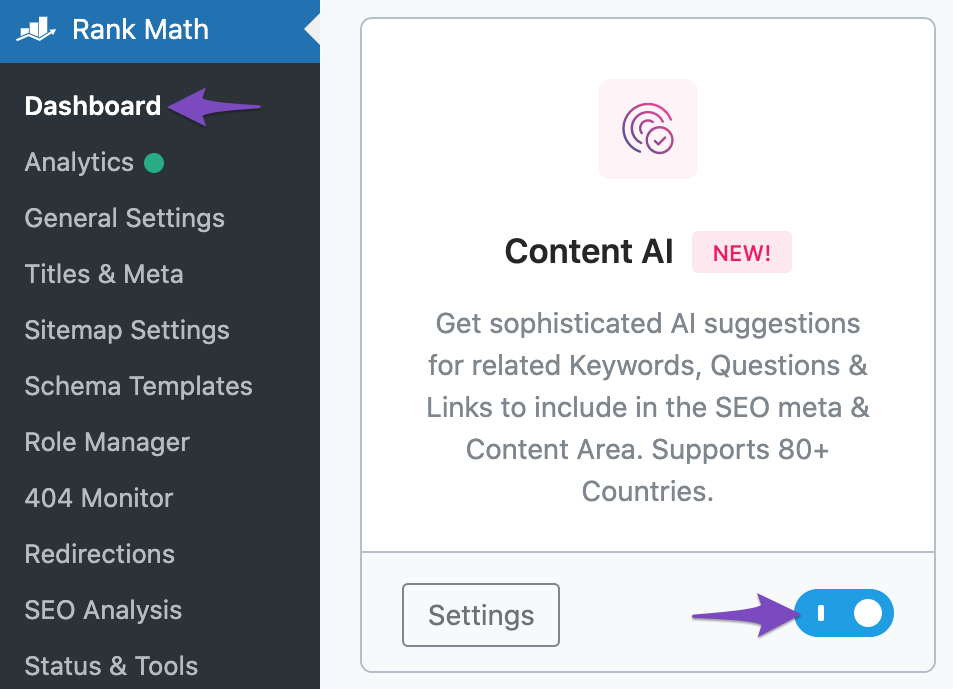
Once enabled, you can access & research for keywords with our Content AI right inside Rank Math’s Metabox. We’ve got a dedicated knowledgebase article to help you use Content AI for researching keywords.
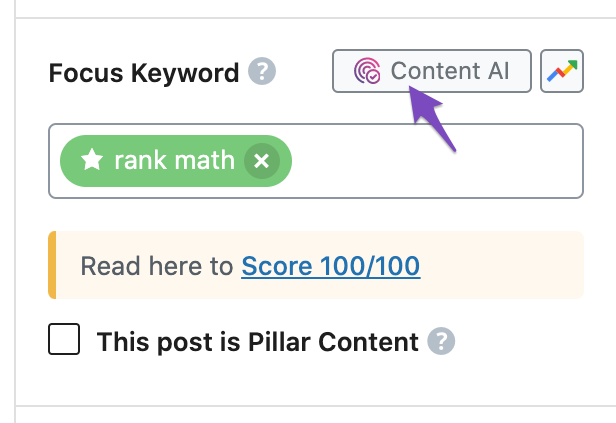
For the researched keyword, our Content AI will analyze and offers suggestions like how many words, links, headings, and media you should use in your content based on what is currently ranking for that keyword. Further, it compares with your actual content and gives an overall Content AI score on a scale of 100. The suggestions and Content AI score can be seen in your WordPress Editor, just like the one shown below.
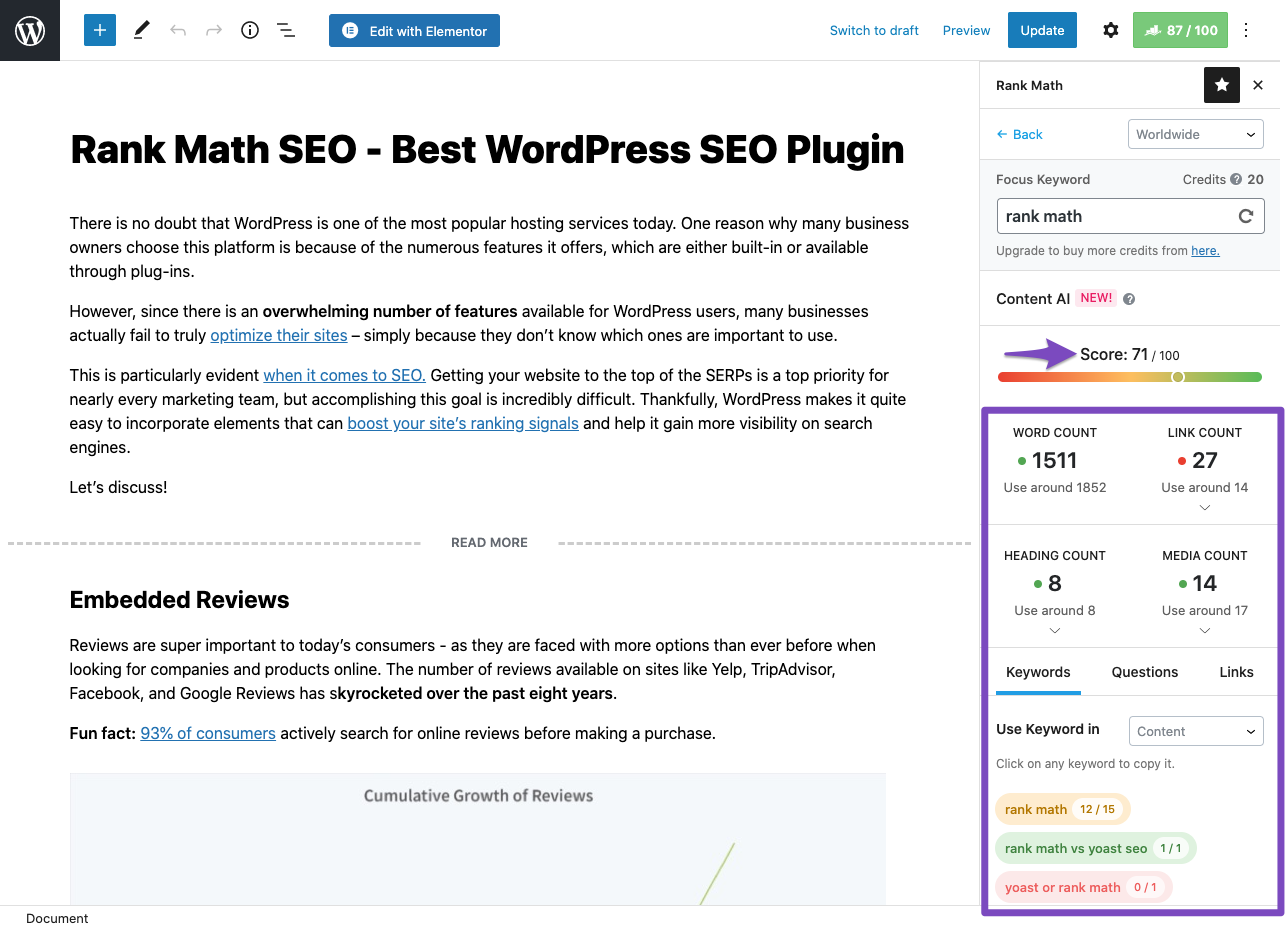
As you can see, the Content AI score is rated on a scale of 100, and scores above 80 will reach the green range on the scale. Any score above 80 simply indicates that your content is optimized for the focus keyword and stands a higher chance of ranking in search results for the targeted focus keyword.
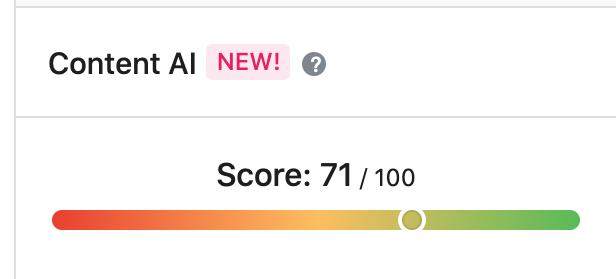
2.1 Color-Codes for Content AI Score
Just like the Content AI score, the various metrics that ContentAI suggests and checks for are also color-coded to give you a quick understanding at a glance, and here is what they mean:
- Green – you’ve successfully passed this test
- Orange – you’ve partially passed the test and can further optimize to achieve Green
- Red – your content isn’t optimized for this metric and you’ve failed the test
- Dark Red – your content includes excessive usage than what is suggested
Now that we’ve understood the color-coding in Content AI, let’s look at the metrics that Content AI uses for assessing the score:
2.2 Word Count
Our Content AI analyzes current search results for the target keyword and indicates the most optimal word count. If your word count is close to what is suggested, then AI will signal it as green.
If your word count falls short and signaled with orange or red, then you can take this opportunity to expand your content with useful information for your audience. But that said, the goal here is to write useful content for your audience & create the best resource available for the target keyword, and you shouldn’t fluff it just to reach the word count.

2.3 Link Count
Since links are important, our AI analyzes the current search results and suggests the number of links to use inside your content. If your link count is in a closer range to what is suggested, it will be signaled as green. On the contrary, if you use too many links, the link count is signaled with dark red.
You can further click the downward arrow to break down internal & external link counts and their suggestions.
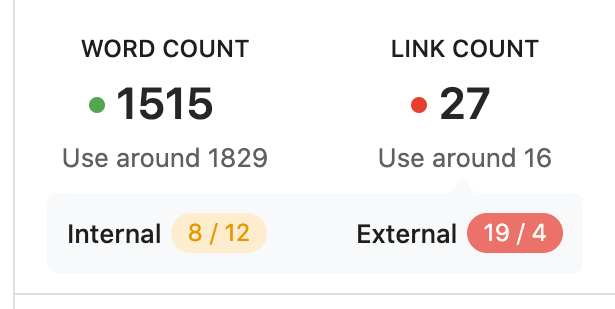
Internal Link Count: Indicates how many internal links you’re using inside your content against the suggested number.
External Link count: Indicates how many external resources are being linked from your content against the suggested number.
2.4 Heading Count
Our Content AI suggests an optimal count for headings to use, based on what is currently ranking for the analyzed keyword and checks for the number of headings used against the count.
If your headings count is within a closer range to the suggested headings count, it would be signaled green in color. In case you’re falling short of headings, you can make use of our AI-suggested questions as headings to expand your content, to pass these checks.
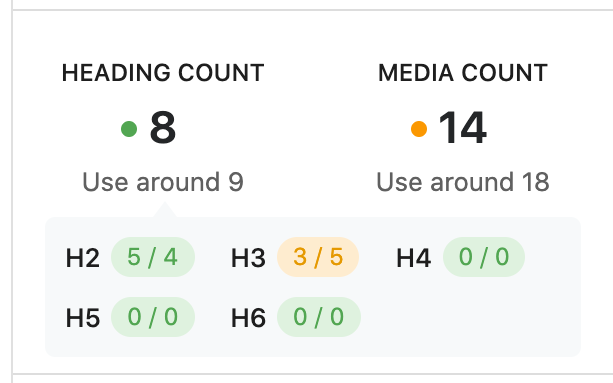
As you click the downward arrow, you can find a further breakdown of heading elements used (H2, H3, H4, H5, and H6) against their suggested count.
2.5 Media Count
As we mentioned earlier, using images and videos can keep your audience engaged for a longer duration on your website. So our AI analyzed the existing search results for the keyword and suggested a media count.
Similar to the various metrics discussed, if you’re using media & its count is closer to what is suggested, you will see a green signal. Else, you would need to add images and video to score green for this test.
You can get a further breakdown of images and video count to use when you click the downward arrow.
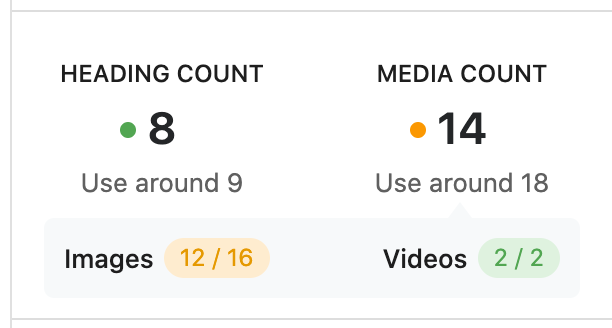
Images Count: Indicates how many images are used inside your content against the suggested number of images.
Video Count: Indicates how many videos are used inside your content against the suggested number of videos.
2.6 Use Keyword In
Using related keywords increases your chances of being ranked for relevant search queries. Our Content AI precisely offers keyword suggestions based on whether the keywords are to be used in Content, Headings, SEO Title, or SEO Description and how often you’ve to use them in your content naturally.
You can select this with the Use Keyword in option, and your keywords suggestions would vary based on what is selected.
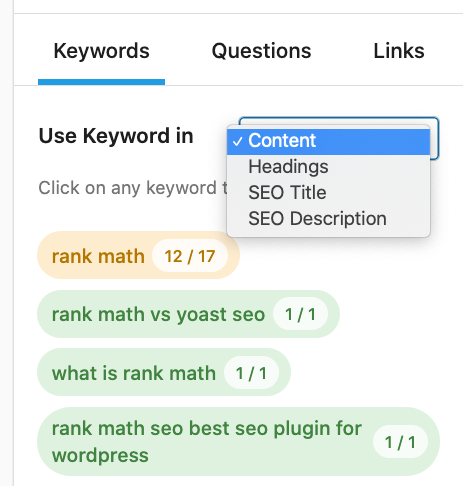
Use Keyword in Content: Our Content AI will check the suggested keywords and the number of times keywords are used in the content for this test.
Use Keyword in Headings: In this test, our Content AI will check if the suggested keywords are used in the Heading.
Use Keyword in SEO Title: For this test, our Content AI looks for the usage of suggested keywords in the SEO Title. Since it’s not ideal to have multiple keywords in the SEO Title, as it looks unnatural, we recommend you use one or two of the suggested keywords.
Use Keyword in SEO Description: Similar to the SEO Title, having multiple keywords stuffed in the SEO Description is not recommended. So use only one or two keywords that best suit the SEO description.
Final Words – Use SEO Score & Content AI Score for Better Optimization
And that’s it! We hope the article helped you understand the SEO score and Content AI score in detail. To quickly summarize,
Our Rank Math SEO score is a quantitative measure of how well your content is optimized for the basic SEO guidelines, such as SEO meta tags, readability, links, etc., while our Content AI gives you a score on how well the content is written around the target keyword.
Henceforth using Rank Math SEO score and Content AI score in tandem ensures that your content is in line with the basic SEO practices and well-optimized for the focus keyword. And, of course, your content will stand a higher chance of ranking for the targeted keyword.
If you’ve any questions on these tests or how to pass any of these tests, then please feel free to reach our support team directly from here, and we’re always more than happy to help.